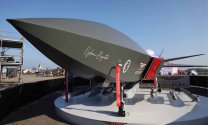I just watched the interview. The pilot explicitly says that the aircraft on display is not a mock-up, that it is the real deal. The structural integration is almost complete as it can be visibly seen. He says that they are seriously studying and working on swarm operations. (Although as far as I can see, it is not the main operational concept that they have envisaged on)It could explain why there are only rivets around the maintenance panels.
You are using an out of date browser. It may not display this or other websites correctly.
You should upgrade or use an alternative browser.
You should upgrade or use an alternative browser.
Turkey Military News, Reports, Data, etc.
- Thread starter Jeff Head
- Start date
Skywatcher
Captain
I was thinking of the thrust weight ratio (granted, I can't remember what the MTOW for the MkII will be)LMAO reminds me of the J-20 amateur evaluations when it just came out. "It's an interceptor/striker not a fighter!"
@CasualObserver I wasn't talking BS when I said that the KE on display is a prototype. I quoted Haluk.
Read before you react.
Read before you react.
Mr Okumuş, the Manager of Tubitak SAGE: "Our hypersonic missiles will have scramjet engines. The most important element in hypersonic systems is material information, cooling systems and test infrastructure. We believe that we can reveal our hypersonic missile at a less cost and shorter development period than its counterparts."
Me: Quote Haluk, literally the CEO of the company.Then don't act as a mindless troll, learn to process the information that is given to you.
When It may have turned out to be a mock-up instead, would it really matter that much to harass others even though you and I both know that it's obviously already in production?
I mean you're behaving like an Iranian claiming that the Qaher 313 is a real 5th gen plane that is able to shoot down other 5th gens with ease. Would everyone believe that claim, or would some people question that instead?
You and I can both be wrong or right depending on the circumstance, but, what matters is discussing everything in a mannerly way.
We get promises from the managers of these programs all the time. They always claim that something is shaping up quite nicely or that a system is entering inventory real soon, but it's quite normal that they may face challenges along the way. A subsystem may not function properly at the last minute before delivery or such. And that is completely normal and expected, but it is by no means an insult to your engineering. When that doesn't happen, don't we have the right to question what is being told to us?
Grow up, dude.
You: NO! IMPOSSIBLE! I don't believe it!
Couple days later an employee of said company is confirming his CEO.
You: Ah yes! It's true.
Me: Told you so.
You: Strawman to the max while coping and seething furiously.
You go back to ignore again. I really shouldn't give people like you second chances because you don't seem to learn of your previous mistakes.
Bare in mind you speak Turkish and I don't. You have better acces to primary sources coming out of Turkiye while I need to do with translation apps and hearsay. You still make more mistakes than I do. Shame on you.
Let’s not get personal and let this thread get out of control as well. I’ve learned my lesson.
Interesting. I wonder if Baykar will follow up on this and optimize the radar stealth characteristics of the Kizilelma a little bit more if needed.I don't know if anyone posted it already, though I like to share this regarding the pro and cons of the canard design on RCS.
There is a research paper addressing the issue in a Chinese publication titled "Radar cross-section effect of canard"
You can download the pdf file at
Basically what they did is use the more accurate MLFMM (multi level fast multipole method) to simulate instead of the Physical Optics simulation algorithm used in "A Preliminary Assessment of Specular Radar Cross Section Performance in the Chengdu J-20 Prototype" by Dr. Carlo Kopp.
After that, they built a canard model to run the RCS test in the anechoic chamber.
View attachment 96936
View attachment 96937
Key takeaway in the paper for canard vs. conventional configuration.
1. Neglectable frontal RCS increase compare to conventional under cruising conditions within +-5° deflection after mitigation.
2. Side RCS is lower than conventional due to no secondary reflection between vertical stabilizer and horizontal stabilizer.
View attachment 96938
Ways to mitigate
1. Apply RAM to the gap between the fuselage and canard
2. Chamfer the rear edge of the canard to reduce scatter
3. Trailing edge parallel to the main wing on the other side
4. Use appropriate structure and RAM material on the trailing edge
View attachment 96940
View attachment 96939
I think this picture shows exactly what those mitigate methods on the J-20
View attachment 96942

